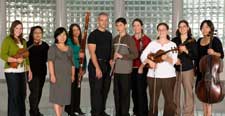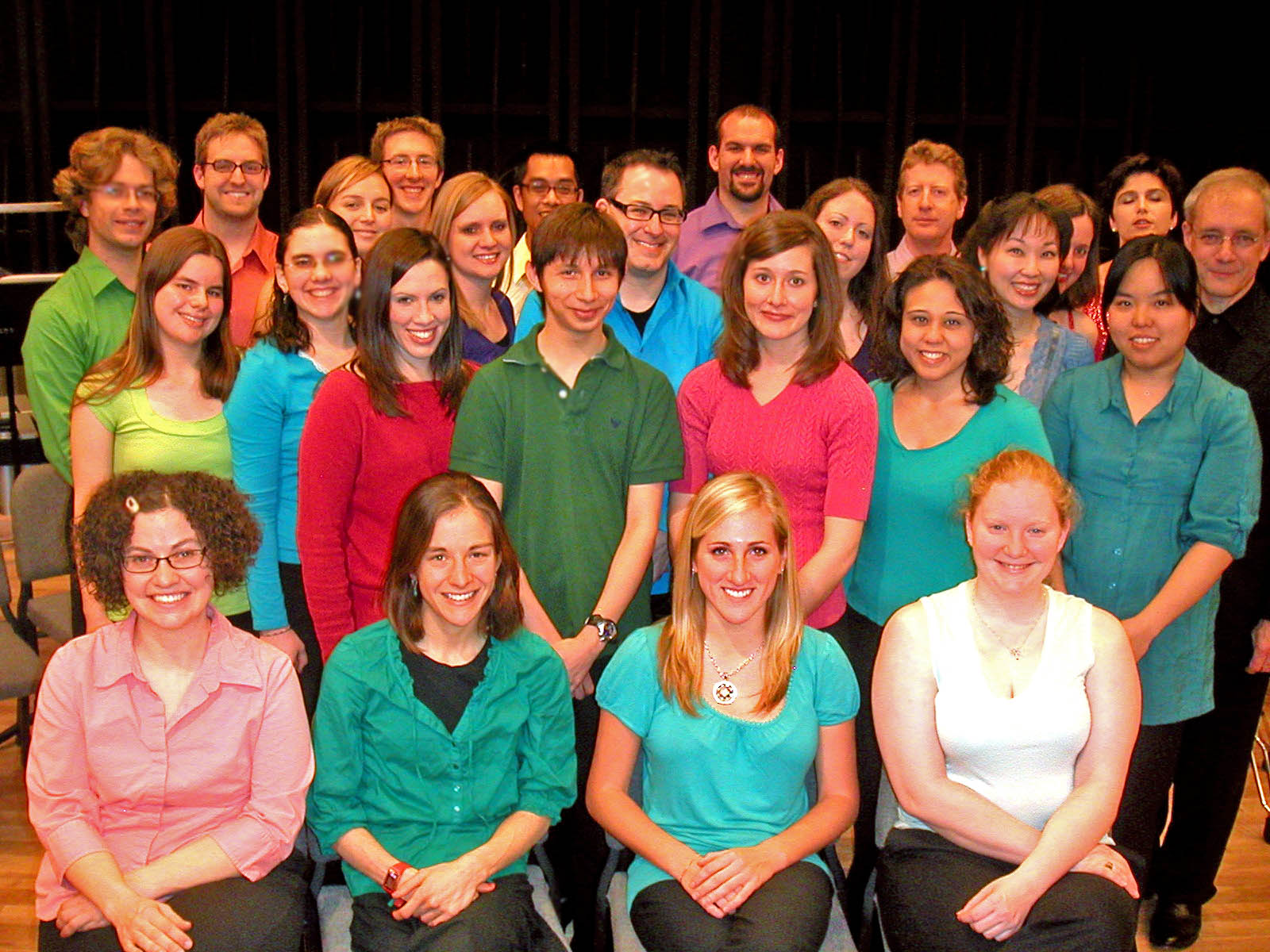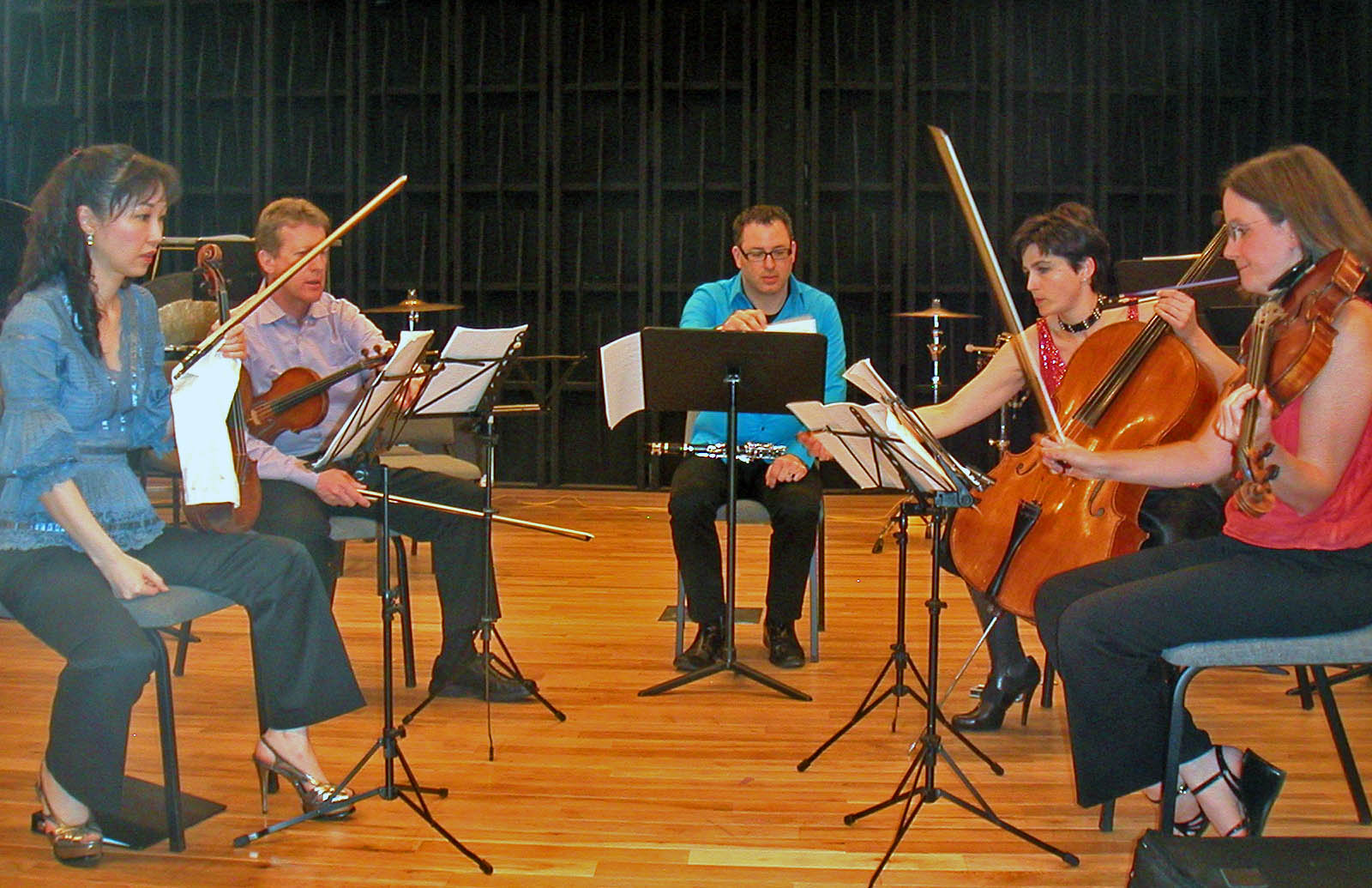
|
| The 2009-10 CNM Ensemble |
Thursday, April 8, 2010, 7:30 p.m.
University of Minnesota, Ted Mann Concert Hall
Friday, April 9, 2010, 8:00 p.m.
University of Wisconsin, Mills Concert Hall
Sunday, April 11, 2010, 7:30 p.m.
University of Iowa, Riverside Recital Hall
CNM Ensemble Spring Tour
|| download program ||
Program
| The Seven Seas (2009) | Stas OMELCHENKO (1982) | |
| Anna Draper, violin I Preston Krauska, violin II Diana Mayne, viola Christina Craig, violoncello Christine Gebler, double bass |
||
| Clarinet Sonata (2007) | Michael FINNISSY (1946) | |
| Michael Norsworthy, clarinet David Gompper, piano |
||
| Erosion (2010) | Matthew DOTSON (1981) | |
| Rolando Hernandez Gaitan, flute Angela Lickiss, oboe Jamie Cox, clarinet Jacqueline Wilson, bassoon Dan Spencer, horn Pamela Schroeder, trumpet Jessica DuCharme, trombone Oliver Molina, percussion I Jonathan Werth, percussion II Louis Nortje, piano Anna Draper, violin I Emily Rolka, violin II Jessica Altfillisch, viola Yoo-Jung Chang, violoncello Christine Gebler, double bass David Gompper, conductor |
||
| — Intermission — | ||
| Trio (2008) | Nicholas S. OMICCIOLI (1982) | |
| Emily Rolka, violin Yoo-Jung Chang, violoncello Grethe Nothling, piano |
||
| Clarinet Quintet (1992) | Magnus LINDBERG (1958) | |
| Michael Norsworthy, clarinet — The Maia Quartet — Tricia Park, violin Zoran Jakovcic, violin Elizabeth Oakes, viola Hannah Holman, violoncello |

Performers
Guest Clarinetist, Michael Norsworthy
Michael Norsworthy's virtuosity, versatility and musicianship has garnered critical acclaim around the globe. As soloist with numerous orchestras around the USA and abroad, as a captivating recitalist and chamber music performer and as one of the most celebrated champions of the modern repertoire having premiered over 100 new works at such venues as Carnegie Hall, Vienna's Musikverein, Moscow's Tchaikovsky Hall, The Casals Festival and the Aspen Festival, Norsworthy has defied categorization, dazzling critics and audiences alike. He has recorded for Mode, Gasparo, Albany, New World, BMOP/sound, Nonesuch, Canteloupe and Cauchemar records. He is principal clarinet with the Boston Modern Orchestra Project, on faculty at The Boston Conservatory, Artist in residence at Harvard University with HGNM and a performing artist for Buffet Crampon and Rico Reeds International. For more info, please visit Michael Norsworthy's website.
Guest String Quartet, The Maia Quartet
Tricia Park, violin, is a recipient of the prestigious Avery Fisher Career Grant and was selected as one of "Korea's World Leaders of Tomorrow" by the Korean Daily Central newspaper. Since appearing in her first orchestral engagement with the Baltimore Symphony Orchestra, Ms. Park has performed with the English Chamber Orchestra, St. Paul Chamber Orchestra, Frankfurt Radio Symphony Orchestra, and National Symphony Orchestra of South Africa; the Montreal, Dallas, Cincinnati, Seattle, Honolulu, Nevada, and Lincoln Symphonies; and the Calgary, Buffalo, and Westchester and Naples Philharmonics. She has also given recitals throughout the United States, including a highly acclaimed performance at the Ravinia Rising Stars series. Recent season highlights include a recital debut at the Kennedy Center, appearances at the Lincoln Center Festival in Bright Sheng's The Silver River, and collaborations with composer Tan Dun, Cho-Liang Lin, Paul Neubauer, Timothy Eddy and Steven Tenenbom. Other recent highlights include performances with the Seattle Symphony under Gerard Schwarz, appearances with the Northwest Chamber Orchestra, her Korean debut performance with the Korean Broadcasting System (KBS) Orchestra and a tour of New Mexico under the auspices of the Santa Fe Chamber Music Festival. Tricia Park received her Bachelor and Master of Music from the Juilliard School where she studied with Dorothy DeLay. Ms. Park is a recipient of the Starling-DeLay Teaching Fellowship at the Juilliard School.
Zoran Jakovcic, violin, studied with Dorothy DeLay at the Juilliard School and at the Cincinnati Conservatory of Music. A native of Croatia, Mr. Jakovcic made his solo orchestral debut at the age of 12 and was a winner of a top prize at the National Competition in Zagreb. He has performed in recital and as soloist with various orchestras in Europe, Japan, China and the US. Mr. Jakovcic was first violinist of the Essex Quartet for ten years. During his tenure, the quartet won numerous competitions and awards, and held residencies at Rutgers, Juilliard, Yale, Meadowmount, Banff and Aspen. Mr. Jakovcic is also an accomplished teacher and administrator. In addition to founding the Arcady International Music Camp and the Thurnauer Summer Chamber Music Camp, he currently serves on the faculty of the Mannes College Preparatory Division.
Elizabeth Oakes, viola, is a founding member of the Maia Quartet at the University of Iowa. As a member of the quartet, she has performed throughout the United States, Europe and Japan and has performed in venues including Alice Tully Hall, Merkin Hall and the Kennedy Center Terrace Theater. In 1997, Ms. Oakes co-founded with two other colleagues, the Foothills Chamber Music Festival in North Carolina and for nine years served both as one of its directors and regular performers. Her passion for interdisciplinary programming has lead to the creation of many large-scale events, including "Scandinavian/Nordicfest" and "Music, Healthcare and Well-Being" at the University of Iowa. She is an active chamber music collaborator, performer and pedagogue in the US and abroad.
Hannah Holman, cello, has performed in England, playing with the English String Orchestra under Yehudi Menuhin and the City of Birmingham Symphony Orchestra under Simon Rattle. An active chamber musician, she was a founding member of the Beaumont Piano Trio, which performed recitals around the United States and England. In her orchestral career, she has been assistant principal cellist of the Richmond Symphony, the American Sinfonietta and performed with the Grand Tetons Festival Orchestra. Hannah has just recently won a position as principal cellist of the Quad Cities Symphony, and performed the Dvorak Cello Concerto with them in 2009. She studied at the Eastman School of Music and Michigan State University, and obtained her MM at the New England Conservatory.
Notes & Bios
Stas OMELCHENKO
The Seven Seas
The concept of The Seven Seas came along when a friend of mine jokingly asked me whether I knew the famous piano piece with the above title. Having replied that I did not, he then proceeded to play, from the lowest to the highest, all the C's of the piano. While I was pleasantly surprised by his joke, I was very much struck by how narrative our mind is; so narrative, in fact, that the very first images I had when hearing the title were not these of the actual notes (an abstract conception) but those of water, waves, and color blue.
In a similarly humorous way, I have decided to take the concept to its other extreme, basing the piece on an abstract conception. What follows is a fast-paced, episodic, textural, timbral, rhythmical, registral, and yes, even narrative exploration of these seas. As a tribute to my friend, I have decided to keep the narrative title.
Stas Omelchenko (b. 1982) has studied composition with David Gompper, Lawrence Fritts, Stacy Garrop, Kyong Mee Choi, Don Malone, Gyula Fekete, and John Eaton. Additional studies and master classes were with Marta Ptaszynska, Bernard Rands, and Mark-Anthony Turnage. He received his Bachelor of Music degree at the Chicago College of Performing Arts at Roosevelt University, and is currently working on his Master of Arts degree at the University of Iowa where he serves as a teaching assistant in music theory.
Michael FINNISSY
Clarinet Sonata
My Clarinet Sonata was written at the suggestion of Michael Norsworthy, and commissioned by "WorldWide Concurrent Premieres". It is one of a set of four works, all 'portraits of' classical sonatas - one for toy piano, looking at Scarlatti; one for bassoon and piano, looking at Schumann's re-working of Bach; one for violin and piano, looking at Brahms; and this one, which takes its template from Beethoven's Op.110. Almost every bar of the right-hand part of Beethoven's piano sonata appears here, though usually in retrograde. The clarinet converses with this material, as one might with a dear friend.
Michael Finnissy was born in London in 1946. He studied at the Royal College of Music, in London, with Bernard Stevens and Humphrey Searle. His work collects together very diverse musical materials, editing them together in a way that is, basically, 'jazzing'. He was President of the ISCM from 1990 until 1996, he currently holds a professorship at the University of Southampton.
Matthew DOTSON
Erosion
In my work I am often drawn to relatively simple systems that unfold before the listener. In Erosion, there are several of these processes that unfold simultaneously. The piece begins with a pitch cluster that gradually spreads into total chromatic saturation (about half-way through the piece) before shrinking back into clusters. As this is happening there is, on a macro level, a gradual speeding of events throughout the entire duration of the work. The interactions between this linear progression in the time domain and the (relatively) cyclical progression in the frequency domain form the main dialogue of the work.
Matthew Dotson (b. 1981) is currently pursuing a PhD in Composition at the University of Iowa where he has studied with Lawrence Fritts, John Eaton and David Gompper in addition to assisting in the operations of the Electronic Music Studios. Recent performances of his music include New York City (New York City Electroacoustic Music Festival), Evanston, Illinois (Midwest Graduate Music Consortium), Cambridge, Massachusetts (Wired for Sound), Belgrade, Serbia (Art of Sounds Festival), Mexico City (Circuito Electrovisiones), and Santiago, Chile (Festival Ai-Maako). Additional info can be found at Matthew Dotson's website.
Nicholas S. OMICCIOLI
Trio for violin, violoncello, and piano
was written for Musica Nova, the University of Missouri - Kansas City's new music ensemble. The work is a reaction from the composer's personal experiences surrounding a life-threatening illness both at an early age and at the time of composing the work.
Nicholas S. Omiccioli (b. 1982) currently studies composition with James Mobberley, Chen Yi, Paul Rudy, and Zhou Long at the University of Missouri - Kansas City. He has received many awards including a commission by the 2010 Wellesley Composers' Conference, winner and judge's choice in the 2007, 2008, 2009, and 2010 UMKC Chamber Music Composition Competitions, 2009 DuoSolo Emerging Composer Award, Kansas City Chorale Crescendo Competition, and the Brian M. Israel Prize. Just recently, Mr. Omiccioli was nominated for an award by the American Academy of Arts and Letters. His music has been performed by DuoSolo, the Kansas City Chorale, The Wellesley Composers' Conference, members of Brave New Works, the Society for New Music, the College Music Society, and numerous SCI Conferences.
Magnus LINDBERG
Clarinet Quintet
When accepting to write a clarinet quintet I first felt scared of the classical ballast of such an ensemble. With the quintets of Mozart and Brahms in mind I felt powerless to imagine any music for this constellation. This turned out to be an interesting paradox during the working process. The fact that the music couldn't be identified by combining unusual instruments together (all these "contemporary music ensemble" pieces) forced me to almost forget the ensemble when starting to write the piece.
This is of course not entirely true, because during many years I have been working a lot with the clarinet in collaboration with my very good friend Kari Kriikku; I tried some compositional ideas based on just a line for clarinet ornamented with the string instruments.
Another starting point was the influence of "Steamboat Bill Jr." a piece for clarinet and violoncello written some years earlier; I made some sketches for clarinet and violoncello "accompanied" by the 2 violins and the alto. My favorite instrument is the orchestra, so I tried to imitate the "tutti" feeling of an orchestral texture scaled to the size of a clarinet quintet.
Despite of its rather extended duration (almost 20 minutes) the work is in one continuous movement. Sections are based on either a static material composed of different scales giving the music an "insect like" appearance, or on directional processes forcing the music to gradually change character or even physically pushing the music to extreme registers or speed. The piece was commissioned by Kuhmo Chamber Music Festival and will be first performed by Kari Kriikku and the Jean Sibelius Quartet in Kuhmo on July 16, 1992.
Magnus Lindberg wrote his first orchestral score at the age of 17, before taking any lessons in composition. He was curious and not afraid of going his own way. He constructed music with post-Webern serial procedures, as if he was trying to explore the limits of a certain way of making music. Theoretical, extremely complex structures were then defying, and often exceeding, the skills of the human performer.
Yet at the same time Lindberg used to take his music theory lessons early on Saturday mornings, playing the classical repertoire arranged for piano duet with his teacher. Knowing what the masters before him had done seemed to urge him to test the boundaries. As his composition teacher Paavo Heininen put it, "if a composer cannot say that he has done something that has not been done before, he cannot say he has done anything at all". In 1985 came Kraft, a study in rhythm and sound. It was the young Lindberg's Rite of Spring. The basic structure and processes were calculated using an elaborate software program, but the focus was already different. Now it looked like Lindberg was challenging the possibilities of musical sound, using scrapyard objets trouves as instruments along with traditional classical sounds. Music burst out with raw, unrefined noise and primitive energy, as in the performances of punk bands that he had heard in Berlin clubs. "Only the extreme is interesting," he declared.
"The orchestra is my favorite instrument," stated Lindberg, confirming something that is clear already by looking at his work list. Aura from 1994 is another revealing piece of the jigsaw puzzle that is, one day, to reveal the full picture of Magnus Lindberg, the composer. Spiritual heir of Sibelius, Lindberg the iconoclast shows that he, too, is able and willing to embrace symphonic thinking.
Technically the music of Magnus Lindberg is based on a solid construction of harmony and rhythm. He often deploys a chaconne technique, where the musical narrative is built over a repeated harmonic sequence. Despite this the music does not sound theoretical, due to the juicy sound world, teeming with life. There is a clear sense of dramaturgy as if the musical characters were protagonists in an abstract drama.
In his most recent works, especially in the concertos for clarinet (2002) and violin (2006), he has also introduced a clear melodic aspect, which was not such a primary concern in his earlier output. After some 30 years of composition and 80 works one observes that Magnus Lindberg is still heading, with a characteristic curiosity, towards unknown territories, and yet remaining true to where he started. Instead of constructing post-modern collages of other composers' music, his works are a reflection of a versatile personality, which distils music history out of an abundance of sonic information. A true composer's statement in music. © Risto Nieminen, 2007
Maia Quartet with Michael Norsworthy
